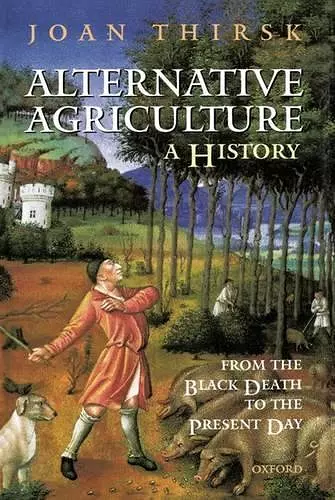Alternative Agriculture: A History
From the Black Death to the Present Day
Format:Hardback
Publisher:Oxford University Press
Published:9th Oct '97
Currently unavailable, and unfortunately no date known when it will be back
This hardback is available in another edition too:
- Paperback£72.00(9780198208136)

A major new history of alternative agriculture
This study of agriculture illuminates the parallels between the changes occurring in agriculture today, and the changes in three other periods (1350-1500, 1650-1750, 1879-1939). Thirsk explains why the same key factors are prominent in today's society and the consequences of acknowledging this.People like to believe in a past golden age of `traditional' English countryside, before large farms, machinery, and the destruction of hedgerows changed the landscape forever. However, that countryside may have looked both more and less familiar than we imagine. Take, for example, today's startling yellow fields of rapeseed, seemingly more suited to the landscape of Van Gogh than Constable. They were in fact, thoroughly familiar to fieldworkers in seventeenth-century England. At the same time, some features that would have gone unremarked in the past now seem like oddities. In the fifteenth century, rabbits were reared in specially guarded warrens as luxury food for rich men's tables; whilst houses had moats not only to defence but to provide a source of fresh fish. In the 1500s we find Catherine of Aragon introducing the concept of fresh salad to the court of Henry VIII; and in the 1600s, artichoke gardens became a fashion of the gentry in their hope of producing more male heirs. The common tomato, suspected of being poisonous in 1837, was transformed into a household vegetable by the end of the nineteenth century, thanks to cheaper glass-making methods and the resulting increase in glasshouses. In addition to these fascinating images of past lives, Joan Thirsk reveals how the forces which drive our current interest in alternative forms of agriculture - a glut of mainstream meat and cereal crops; changing patterns of diet; the needs of medicine - have striking parallels with earlier periods of our history. She warns us that today's decisions should not be made in a historical vacuum. We can still find solutions to today's problems in the hard-won experience of people in the past.
an elegant and humane work ... Thirsk's particular success lies in her breadth of treatment, in her reflections and comparative insights, and in her compassion ... Thirsk comes across as a champion of human endeavour, perhaps even a believer in human progress. When she chastises she does so gently. Nonetheless, the work contains implicit warnings. * Peter Coss, Social History Bulletin *
Many years of research have gone into the making of this important and intriguing book./ ... we have here remarkably interesting and valuable discussions of the cultivation of rapeseed, woad, madder, mulberry trees, safflower and weld, as well as the early development of vines and tobacco./ This story, with its many references to historical antecedents and similarities, is certain to arouse great interest and gives much food for thought./ ... we must all be grateful to Joan Thirsk for a book which provides so much interest and stimulus to discussion. It is, as one would expect, beautifully written, and is attractively illustrated and handsomely produced./ G. E. Mingay, The Agricultural History Review, Vol 46, part 2, 1998.
This is clearly a book ... which should be read by farmers and policy makers as well as by historians. * J. R. Worde Economic History Review *
immensely detailed in its research ,.,, there's nothing dry as dust about this history ... What Joan Thirsk has written is, at least in its implications, a firebrand of a book ... What is exciting about Joan Thirsk's book is the clarity and detail in which she reveals how often we have been here before. * Adam Nicolson, Evening Standard (London) *
I would make it compulsory reading for those concerned with rural and agricultural policy and with food, health, and drug abuse as well. * The Times Higher Education Supplement *
Join the library queue for this book ... this long book takes seriously our current crop of organic horticulturalists and post-industrial workshop aspirants. * Colin Ward, Red Pepper *
...carefully researched and thoughtful volume...a wealth of detail. It is difficult to do justice to Thirsk's wide-ranging study in a short notice. - R J Moore-Colyer. British Journal for 18th C Studies. Vol 21. 1998
Thirsk's brilliant study of six centuries of British agriculture affirms her status as the preeminent scholar of the subject ... Thirsk's fascinating study is rich in detail about the successes and failures of experimentation ... Highly recommended to readers and libraries interested in British studies, agricultural history, and the history of diet and nutrition. * C. W. Wood Jr, CHOICE *
bristles with such fascinating details which challenge notions about what is traditional and what is innovative in English agriculture ... Thirsk's stimulating and often entertaining account is partly a work of history and partly a manifesto on the future of agriculture * Clare Griffiths, Wadham College, Oxford, EHR, June 1999 *
there is a sense of fidelity which protects her work against the vagaries of academic fashion. Nowhere are these qualities clearer than in Alternative Agriculture. Firstly, there is the sheer scale and learning of the book ... it moves easily and with elegance from an England traumatized by the Black Death to an England learning to live with BSE ... this is not only a broad-sweep history but also a complex and minute examination of the processes of agricultural change ... Alternative Agriculture is a marvellouw justification of the historian's craft - a book which is both a careful and engrossing account of our past and a text which speaks into current debates and arguments. I wish I had written it. * Alun Howkins, History Workshop Journal, vol 47, 1999 *
ISBN: 9780198206620
Dimensions: 243mm x 164mm x 24mm
Weight: 734g
376 pages